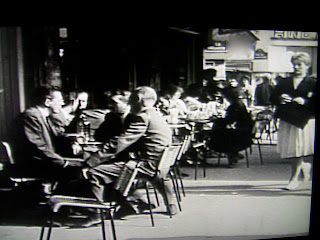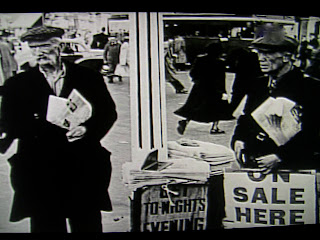2012 Photo Exhibit at the Maison Européenne de la Photographie-Paris
cinema media writing atelier short story south east Asia pop culture tour travel voyage articles author art journal magazine museum expo gallery exhibit crafts clothing designer small business local manufacture San Francisco Haight street life Paris fashion photo graph show café cool mode style Europe France French China Hong Kong film review movie director act Book Reading literature video icon music Group underground news performance
Le Peuple Russe, 1955
Place Tian An Men, Peking, Chine 1958
Henri Cartier-Bresson, Photographer and Self-Styled PickPocket
Three Documentaries about Henri Cartier-Bresson
and
Three Documentaries by Henri Cartier-Bresson
l'Aventure Moderne, Director Roger Kahane 1975
This features interviews of Henri Cartier-Bresson, and footage of walking the streets, "stealing" his photos, glimpses of life around him
Henri Cartier-Bresson : nous sommes les pick pocket, un peu
"we are a bit like pick pockets (photographers)"
ce sont des détails vivantes, des detailles juste
un jeu de lignes, des formes
un moyen de dessiner, de faire mon journal
la grande jouissance... quand on trouve le beau moment... c'est un lien entre le sujet qu'on sent intuitivement et une composition rigoureuse, enfin, une geometrie qui vous surprend ca c'est une fraction d'une seconde
c'est le seul moment de creation...
"these are the lively details, the perfect moments
the play of lines and of form
a way of designing of making my journal
the great moment of joy... when one finds the perfect moment
one intuits the link between the subject and a rigorous composition
in fact, a kind of geometry which surprises you
and it lasts only for a fraction of a second
this is the sole moment of creation...
images of Henri Cartier-Bresson at work and at interviews by director, stills from l'Aventure Moderne, Director Roger Kahane 1975
Henri Cartier-Bresson talks of the difficulty of photographing the peoples of different cultures in a spontaneous, candid fashion, unposed : "Americans are more open, everyone has a camera, they don't mind what you do..."
on fouette pas l'eau quand on veut pecher
c'est très délicat
les Chinois sont un peu méfiants, les Français aussi
mon metier ce n'est pas un metier des gens tres polis...
"one does not stir up water before fishing
photography is very delicate
the Chinese are not very trusting, the Frensh also (of cameras)
it is necessary to have patience, great politeness...
but my profession is not a profession of people who are very polite"
"the Chinese want to pose themselves in a dignified manner, very closed on a personal level", boutonné
Find references to photographing people of the Chinese cultures in the early post on painter Yue Minjun, kweejibo stories
les Italiens, immédiatement, ils posent...
j'étais obliger de me cacher
il faut comprendre la mentalite les gens ... leurs gouts
"the Italians pose, immediately, (at the sight of a camera)
I am obliged to hide myself (in order to catch them being spontaneous)"
les détails justes, ca peut etre un regard, dans l'epoch .... une verité encore fugitive, plus intérieure, pour arriver de saisir cette profondeur de l'être, il faut que le modèle oublie complètement l'appareil
on déshabille tout de même les gens
il y a un espèce de viol, n'est-ce pas?
on est assassin... on frappe, on s'enfuit
"the perfect detail, that could be just a look, in a period of time... a still fleeting truth, more interior, to arrive at grasping the depth of a person, it is necessary that the model forgets the camera
one undresses people, in a sense,
a kind of stealing, a violation
we are assassins, then we flee..."
Henri Cartier-Bresson photographed Gandhi, on his deathbed surrounded by his family, Nehru, the funeral of Gandhi
En Inde, on peut pas photographer les femmes
"In India, we could not photograph the women..."
There was a very beautiful young girl he wanted to photograph
and his Indian guide explained that if someone photographed his wife :
je serai obliger de les tuer a mes propres mains
"I would be obliged to kill him (the photographer) with my own hands"
His guide told people that Cartier-Bresson was weak in the head and played with a camera, that he didn't take photos, in order for Henri to get his shots.
Cartier-Bresson's friend Robert Capa, another photographer decided to form an agency called Magnum, a cooperative ofappproximately twenty photographers, with Henri's participation.
Cartier-Bresson makes the sign of the cross when speaking of a woman who helped the penniless Magnum to survive; she sold tickets for racehorses and gave Capa information on how to bet and win.
That's how the agency survived.
Contacts, Director Robert Delpire (1994)
Henri Cartier-Bresson managed portraits of the following, as well as many more :
Balthus Faulkner, Coco Chanel
Truman Capote
Irene and Frederic Joliot-Curie
Saul Steinberg
painter Pierre Bonnard
Isabelle Huppert
Henri Cartier-Bresson shows a photo of actress Huppert :
il y'a des gens qu'on n'arrive pas a photographer... ils connaissent trop bien leur metier... les hommes politiques, les acteurs...un acteur ..comme est-ce que je vous fait? tragique... comique, sentimentale?
"there are people that one fails to capture... because the subject knows too well his or her profession, politicians, actors ... what shall I do for you? tragedy, comedy, sentimality?
This scene is most amusing compared to a scene from a later documentary on the work of Henri Cartier-Bresson, as seen both by him and others...
Henri Cartier-Bresson, Biographie d'un regard de Heinz Butler (2003)
Isabelle Huppert, chooses the same photo, as in the documentary, Contacts, the photo that Henri Cartier-Bresson declared a failure :
il y avait un qui se détachait de l'eau... quand il était en face de moi, j'avais conscience qu'il voyait quelque chose en moi que je connaissais pas, que j'allais decouvrir... il saisit quelque chose de moi, et pourtant je suis bien placée pour me connaitre, j'en ai fait beaucoup de photos.. et tout d'un coup, il y avait quelque chose inattendue ... profondement juste
"there was one photo which detached itself from the others ...
in front of this, I became conscious of something in me that I had no knowledge of,
that I was in the middle of discovering
he caught something in me, and I am already well-placed to know myself, I have taken many photos, and yet all of a sudden, there was soemthing completely unexpected, and profoundly exact..."
Documentaries made by Henri Cartier-Bresson :
Victoire de la Vie, 1937, documentaire sur l'entraide medicale au service de l'Espagne republicaine assailllie par les troupes du Général Franco
L'Espagne vivra, 1938, documenatire sur la guerre d'Espagne, réalisé pour le compte du Secours Populaire, avec un commentaire de Georges Sadoul
Impressions de Californie, Southern Exposures, Carnets de voyage d'Henri Cartier bresson dans l'Amérique profonde, tournés en 1970 pour le compte de la chaine de télévision CBS News
the first two photos taken at the Maison Européenne de la Photographie-Paris
the rest of the images are stills from :
l'Aventure Moderne, Director Roger Kahane 1975
Contacts, Director Robert Delpire (1994)
Henri Cartier-Bresson, Biographie d'un regard de Heinz Butler (2003)
























